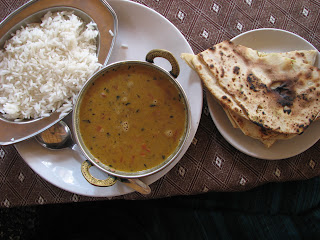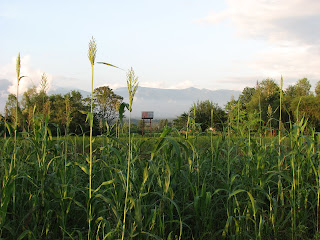Namaste! I have reached my destination Bija Vidyapeeth (seed college). It is hard to believe that I touched down in Delhi less than 48 hours ago and I already have blisters (challas) on my thumbs from removing corn kernels! I had anticipated something to go wrong in between the lack of sleep, death-defying taxi ride through Delhi, walk to the train station, actually finding my train and seat, and eventually finding a cab to the farm, but it all went pretty smoothly. The journey (yatra) was actually quite fun! Upon arrival at Indira Gandhi Airport my nerves were overtaken by a sense to appear confident and to hold onto my luggage with a vice grip. However, I had no troubles at all. Although I had no idea where I was going, I kept on walking as if I did, until I found an information desk. They pointed me in the direction of the prepaid taxis. I paid 300 rupees (just over $6) for about a half-hour ride to Hotel Raj in Paharganj (a neighborhood in Delhi near train station). It amazed me we did not hit a bicyclist or side-swipe a bus along the way.
The Hotel Raj was exactly what I needed. Although it lacked a hot shower (not something I especially needed in the heat) it felt good to stretch out my legs in the big, clean bed; brush my teeth; and hop on the Internet upon my arrival. The front desk was extremely helpful and accommodating, as well. I would definitely recommend a stay there if ever in Delhi. Since I arrived there at dark and left the next morning at dark, I can't say much about the surrounding neighborhood. However, it was pretty loud and I wouldn't say I would have felt extremely safe walking around at night.
My train to Dehradun left at 6:50 the next morning, but it was pouring so the hotel called me a rickshaw. Again, that was quite the experience. I am glad I did not walk the mile to get there because the streets were absolutely flooded with rainwater containing who knows what. There were many rickshaws lined up at the train station with men sleeping inside before they started their long day. Once at the train station I had no idea what I was doing, but again, walked like I did, and ended up following a family into the station. We pushed our way through the "security gate" (like you'd see at an airport, where you put your bag through a scanner and walk through the metal detector, but there was no order at all, you just pushed your way through and back to the belt again to grab your bag on the other side).
Once inside the station I continued walking like I knew what I was doing, but had lost the family in the security hubbub. I realized I was definitely in the wrong place once I saw no more families and just saw people sleeping on the ground, so I casually turned back around and found a mass of people walking up some stairs. All I knew was I was going to Dehradun, and I had a ticket that said E2 56, and had no idea what that meant. As I was walking up the stairs I caught the tail end of an announcement, "Dehradun, platform 16" It was then I looked up an realized that there indeed were numbered platforms. I was on platform 1 and just had to keep walking through the mass of people to get to 16. Once I was on platform 16, I realized each train car was labeled with the G2, G1... E2, etc. which seemed to have no order to me. Once I found E2 I then saw I had seat 56 and it was all easy as pie! My request for a window seat must have been denied because I was sat in the aisle. Fortunately, a lady asked if I could switch seats so she could sit next to her family, which sent me up to seat 9 next to the window and to Dr. Promode Kant who is the Director for the Institute of Green Economy. I'll have to write a whole new blog post on him and my discussion with him in my next post. But I also still have to introduce the farm! So much to write about!
The train ride has been my favorite part of the journey so far. It took about 6 hours to get up to Dehradun and I had a wonderful introduction to India the entire time. We passed many slums nestled right up against the train tracks. Their backyards included everything from cows, to pigs, to goats, to chickens, to massive heaps of trash. I could have ridden the train all day. It was my first time in air-conditioning, which was very nice, and there was food and tea and a new newspaper in front of me the whole time.
Once in Dehradun I received the most attention from the rickshaw drivers. They came up to me right at the exit and tried to get me to come with them. I kept walking, again, like I knew where I was going and found myself a prepaid taxi stand again. I definitely stood out here, being the only white person. In Delhi there were a few other obvious foreigners, but I felt pretty special here. At the cab stand, they didn't speak English, so my poor pronunciation of Ramgarh (the village where Bija Vidyapeeth is near) didn't get me anywhere. I eventually just gave them my notebook that showed directions here and they figured it out. I hopped in another cab for 560 rupees and took another pretty scary ride. But they brought me directly to the farm. Once here I was fed a delicious and filling meal. More on the farm later!
Here are a few poor-quality pictures I took on the rainy train ride, but it is all I have taken so far:
































